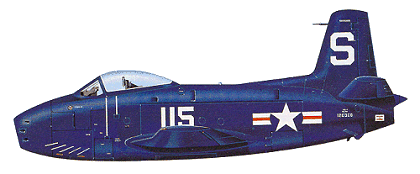 |
North American FJ-1 Fury1946 |  |
| CARRIER-BORNE FIGHTER | Virtual Aircraft Museum / USA / North American |
 |
A significant aircraft in North American Aviation's history, the FJ-1 Fury was the company's first gas turbine powered aircraft, the first of a long line of jet fighters produced by the company and progenitor of the world beating F-86 Sabre family. Although built only in small numbers for the US Navy, the original straight-wing FJ-1 Fury was (along with the USN's similarly conservative McDonnell FH-1 Phantom and Vought F6U Pirate) part of the important and necessary transition period between piston engined fighters and the swept wing jets which would follow. A US Navy contract for the building of three XFJ-1 prototypes was awarded to North American on 1 January 1945, the company designation being NA-134. Designed around the General Electric J35 axial flow turbojet, NAA chose a simple configuration with a nose intake and straight through airflow to the engine in the rear fuselage. This necessitated putting the cockpit above the intake ducting and resulted in a short and stumpy looking fuselage. The armament ot six 12.7mm machine guns was installed on the sides of the nose. Fuel was housed in the fuselage and in tip tanks on production aircraft. The first XFJ-1 Fury flew on 27 November 1946, by which time the US Navy had ordered an additional 100 production FJ-1s but this was cut to only 30 by the time deliveries began in March 1948. Production aircraft were powered by J35-A-2 engines buitt by Allison. The Fury was quickly overtaken by the rapid pace of jet fighter development and remained in front line USN service for only 14 months before being relegated to Naval Reserve units. The only operational squadron to fly the aircraft was VF-5A (later VF-51) operating aboard the carrier USS Boxer. The first carrier landings were performed on 10 March 1948 and VF-5A became the first jet fighter unit to go to sea under operational conditions. The FJ-1 also had another claim to fame for a brief time in 1947 when one of the prototypes achieved a speed of Mach 0.87, the fastest by any US fighter to that point. The later FJ-2, -3 and -4 Fury models were naval developments of the Sabre and despite their designation similarity with the original aircraft, had little in common with it apart from being the result of the evolutionary process the FJ-1 had started.

|  COMPANY PROFILE | ||||||||||||||||||||||||||||||||||||||||||||||||||||||||||||
 |

|

